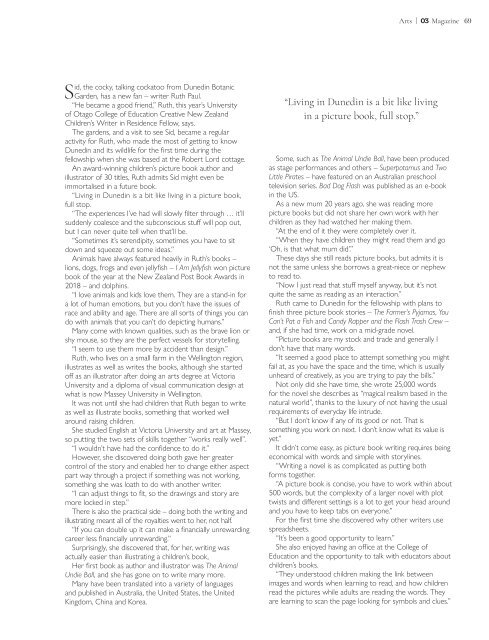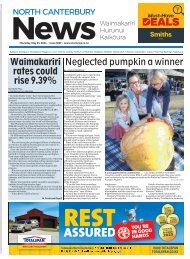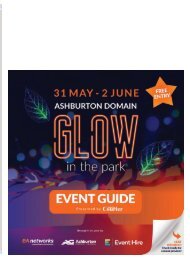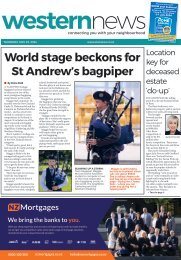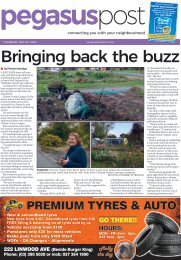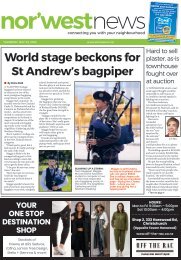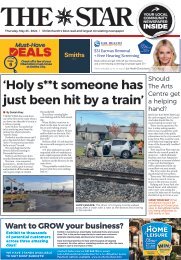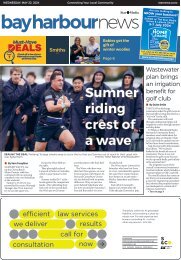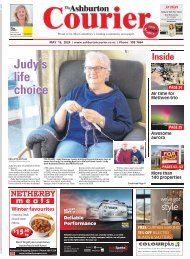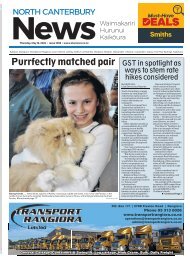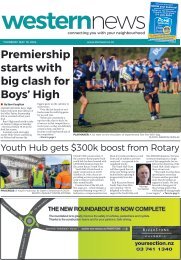03 Magazine: October 02, 2023
You also want an ePaper? Increase the reach of your titles
YUMPU automatically turns print PDFs into web optimized ePapers that Google loves.
Arts | <strong>Magazine</strong> 69<br />
Sid, the cocky, talking cockatoo from Dunedin Botanic<br />
Garden, has a new fan – writer Ruth Paul.<br />
“He became a good friend,” Ruth, this year’s University<br />
of Otago College of Education Creative New Zealand<br />
Children’s Writer in Residence Fellow, says.<br />
The gardens, and a visit to see Sid, became a regular<br />
activity for Ruth, who made the most of getting to know<br />
Dunedin and its wildlife for the first time during the<br />
fellowship when she was based at the Robert Lord cottage.<br />
An award-winning children’s picture book author and<br />
illustrator of 30 titles, Ruth admits Sid might even be<br />
immortalised in a future book.<br />
“Living in Dunedin is a bit like living in a picture book,<br />
full stop.<br />
“The experiences I’ve had will slowly filter through … it’ll<br />
suddenly coalesce and the subconscious stuff will pop out,<br />
but I can never quite tell when that’ll be.<br />
“Sometimes it’s serendipity, sometimes you have to sit<br />
down and squeeze out some ideas.”<br />
Animals have always featured heavily in Ruth’s books –<br />
lions, dogs, frogs and even jellyfish – I Am Jellyfish won picture<br />
book of the year at the New Zealand Post Book Awards in<br />
2018 – and dolphins.<br />
“I love animals and kids love them. They are a stand-in for<br />
a lot of human emotions, but you don’t have the issues of<br />
race and ability and age. There are all sorts of things you can<br />
do with animals that you can’t do depicting humans.”<br />
Many come with known qualities, such as the brave lion or<br />
shy mouse, so they are the perfect vessels for storytelling.<br />
“I seem to use them more by accident than design.”<br />
Ruth, who lives on a small farm in the Wellington region,<br />
illustrates as well as writes the books, although she started<br />
off as an illustrator after doing an arts degree at Victoria<br />
University and a diploma of visual communication design at<br />
what is now Massey University in Wellington.<br />
It was not until she had children that Ruth began to write<br />
as well as illustrate books, something that worked well<br />
around raising children.<br />
She studied English at Victoria University and art at Massey,<br />
so putting the two sets of skills together “works really well”.<br />
“I wouldn’t have had the confidence to do it.”<br />
However, she discovered doing both gave her greater<br />
control of the story and enabled her to change either aspect<br />
part way through a project if something was not working,<br />
something she was loath to do with another writer.<br />
“I can adjust things to fit, so the drawings and story are<br />
more locked in step.”<br />
There is also the practical side – doing both the writing and<br />
illustrating meant all of the royalties went to her, not half.<br />
“If you can double up it can make a financially unrewarding<br />
career less financially unrewarding.”<br />
Surprisingly, she discovered that, for her, writing was<br />
actually easier than illustrating a children’s book,<br />
Her first book as author and illustrator was The Animal<br />
Undie Ball, and she has gone on to write many more.<br />
Many have been translated into a variety of languages<br />
and published in Australia, the United States, the United<br />
Kingdom, China and Korea.<br />
“Living in Dunedin is a bit like living<br />
in a picture book, full stop.”<br />
Some, such as The Animal Undie Ball, have been produced<br />
as stage performances and others – Superpotamus and Two<br />
Little Pirates – have featured on an Australian preschool<br />
television series. Bad Dog Flash was published as an e-book<br />
in the US.<br />
As a new mum 20 years ago, she was reading more<br />
picture books but did not share her own work with her<br />
children as they had watched her making them.<br />
“At the end of it they were completely over it.<br />
“When they have children they might read them and go<br />
‘Oh, is that what mum did’.”<br />
These days she still reads picture books, but admits it is<br />
not the same unless she borrows a great-niece or nephew<br />
to read to.<br />
“Now I just read that stuff myself anyway, but it’s not<br />
quite the same as reading as an interaction.”<br />
Ruth came to Dunedin for the fellowship with plans to<br />
finish three picture book stories – The Farmer’s Pyjamas, You<br />
Can’t Pat a Fish and Candy Rapper and the Flash Trash Crew –<br />
and, if she had time, work on a mid-grade novel.<br />
“Picture books are my stock and trade and generally I<br />
don’t have that many words.<br />
“It seemed a good place to attempt something you might<br />
fail at, as you have the space and the time, which is usually<br />
unheard of creatively, as you are trying to pay the bills.”<br />
Not only did she have time, she wrote 25,000 words<br />
for the novel she describes as “magical realism based in the<br />
natural world”, thanks to the luxury of not having the usual<br />
requirements of everyday life intrude.<br />
“But I don’t know if any of its good or not. That is<br />
something you work on next. I don’t know what its value is<br />
yet.”<br />
It didn’t come easy, as picture book writing requires being<br />
economical with words and simple with storylines.<br />
“Writing a novel is as complicated as putting both<br />
forms together.<br />
“A picture book is concise, you have to work within about<br />
500 words, but the complexity of a larger novel with plot<br />
twists and different settings is a lot to get your head around<br />
and you have to keep tabs on everyone.”<br />
For the first time she discovered why other writers use<br />
spreadsheets.<br />
“It’s been a good opportunity to learn.”<br />
She also enjoyed having an office at the College of<br />
Education and the opportunity to talk with educators about<br />
children’s books.<br />
“They understood children making the link between<br />
images and words when learning to read, and how children<br />
read the pictures while adults are reading the words. They<br />
are learning to scan the page looking for symbols and clues.”


